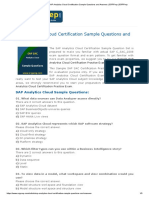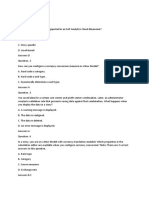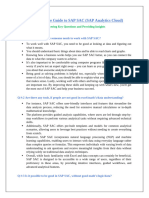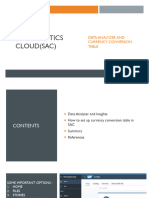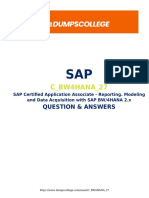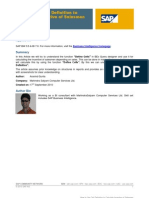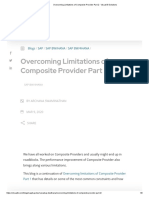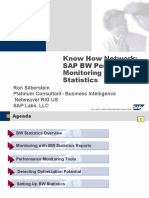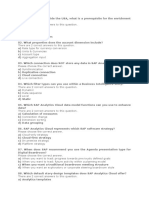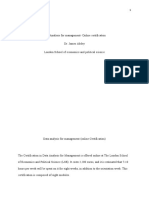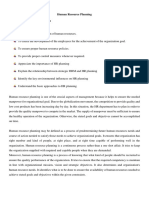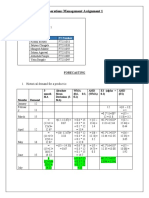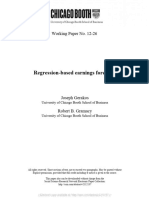SAC Test
Uploaded by
mayue2114SAC Test
Uploaded by
mayue2114Unit 1
Learning Assessment - Answers
1. SAP Analytics Cloud includes Enterprise Planning, Augmented Analytics, Enterprise
Platform Services, and Business Intelligence. True or false?
Determine whether this statement is true or false.
X True
X False
SAP Analytics Cloud includes Enterprise Planning, Augmented Analytics, Enterprise
Platform Services, and Business Intelligence.
2. You want to use the embedded help function in SAP Analytics Cloud to support you. What
is offered by the embedded help?
Choose the correct answers.
X A Guided help tutorials
X B Live chat with experts
X C Videos
X D Chatbot
The SAP Analytics cloud embedded help function includes guided help tutorials, videos,
and classical help documents, but no live chat or chatbot.
3. The Data Access Language option determines the preferred language for which areas of
SAP Analytics Cloud?
Choose the correct answers.
X A Imported Data
X B Live Data
X C Text
X D Help
The Data Access Language option determines the preferred language for Live Data and
Text but not imported data or help.
© Copyright. All rights reserved. 23
Unit 1: Learning Assessment - Answers
4. In the SAP Analytics Cloud Catalog, what access do you have to the files?
Choose the correct answer.
X A Read/Write
X B Edit
X C View
The Catalog provides only View access to files.
5. What are the three primary access levels you can assign when sharing files?
Choose the correct answers.
X A Read Only
X B View
X C Read/Write
X D Edit
X E Full Control
The access levels available when sharing are View, Edit, Full Control, and Custom.
6. When scheduling a publication, what are the two file type options?
Choose the correct answers.
X A .pdf
X B .pptx
X C .csv
X D .txt
When scheduling a publication, the only file types available are .pdf and .pptx
7. When you are scheduling, to how many non-SAP Analytics Cloud recipients can you
distribute?
Choose the correct answer.
X A 100
X B 3
X C 33
You can distribute to only 3 non-SAP Analytics Cloud recipients.
24 © Copyright. All rights reserved.
Unit 1: Learning Assessment - Answers
8. Your users need a story where the pages adjust the size and location of the elements on
the page depending on the device, or size of device, being used to view the story. What
page type should you use?
Choose the correct answer.
X A Responsive
X B Canvas
X C Grid
A responsive page adjusts the size and location of the elements on the page depending on
the device, or size of device, being used to view the story.
© Copyright. All rights reserved. 25
Unit 2
Learning Assessment - Answers
1. In SAP Analytics Cloud you use an import connection to an SAP ERP system. Your
colleague says that no data is stored in SAP Analytics Cloud. Is the statement of your
colleague true or false?
Determine whether this statement is true or false.
X True
X False
With an import connection, data is duplicated from the on-premise datasource and stored
in SAP Analytics Cloud.
2. With a live data connection, where is the data security defined?
Choose the correct answer.
X A Data security is defined in SAP Analytics Cloud.
X B Data security is defined in the connection created in SAP Analytics Cloud.
X C Data security is defined in the source system.
With a live connection data security is defined in the source system.
3. What are the data sources for Data Analyzer?
Choose the correct answers.
X A SAP BW Queries
X B SAP HANA Live Views
X C SAP Datasphere
X D CSV files
X E Microsoft Excel files
X F SAP Analytics Cloud Models
The data sources for Data Analyzer are SAP BW queries, SAP HANA Live views, SAP
Datasphere and SAP Analytics Cloud models.
© Copyright. All rights reserved. 35
Unit 2: Learning Assessment - Answers
4. You use Data Analyzer for a quick analysis of data, and you save your analysis results.
What is the file type?
Choose the correct answer.
X A Insight
X B Application
X C Table
Data Analyzer saves an Insight.
36 © Copyright. All rights reserved.
Unit 3
Learning Assessment - Answers
1. What elements make up the framework for viewing data in SAP Analytics Cloud?
Choose the correct answers.
X A Dimensions
X B Allocations
X C Properties
X D Measures
Dimensions and measures are the framework for viewing data.
2. What are the styles of models?
Choose the correct answers.
X A On-premise
X B Analytic
X C Planning
X D Live
In SAP Analytics Cloud there are two styles of models: Analytic and Planning.
3. A model where the data is read-only must contain a date dimension.
Determine whether this statement is true or false.
X True
X False
A date dimension is optional in a model that is read-only.
52 © Copyright. All rights reserved.
Unit 3: Learning Assessment - Answers
4. A dataset can have column-based security applied to it.
Determine whether this statement is true or false.
X True
X False
Specific column-based or property security is not supported for any datasets.
5. What are the types of datasets in SAP Analytics Cloud?
Choose the correct answers.
X A Embedded
X B Public
X C Live
X D Import
SAP Analytics Cloud has two types of datasets: Embedded and Public.
6. Which data source does not require a model be created for it in SAP Analytics Cloud for
use in stories?
Choose the correct answer.
X A SAP Datasphere
X B Microsoft SharePoint
X C SAP Business Warehouse (BW)
SAP Datasphere requires a connection be created in SAP Analytics Cloud, but no SAP
Analytics Cloud model is necessary
7. What elements can you import data into in SAP Analytics Cloud?
Choose the correct answers.
X A Dimensions
X B Stories
X C Analytic Models
X D Planning Models
Data can be imported in dimensions, planning models, and analytic models.
© Copyright. All rights reserved. 53
Unit 3: Learning Assessment - Answers
8. It is possible to concatenate a First Name dimension with a Last Name dimension into one
Full Name dimension in a live model.
Determine whether this statement is true or false.
X True
X False
You cannot manipulate any data in a live model.
9. With an import model, when changes happen in the original data source, what happens in
the SAP Analytic Model?
Choose the correct answer.
X A Only the changes in the original data source are transferred to the model;
unchanged data is not transferred.
X B All data in the original data source is transferred to the model, including unchanged
data.
X C Nothing. The changes in the original data source are not reflected in the model.
Changes in the original data source are not reflected in the model.
54 © Copyright. All rights reserved.
Unit 4
Learning Assessment - Answers
1. You created a story and want to share it with an external agent, who does not have SAP
Analytics Cloud. You decide to export the story as a file. Which file type can be used?
Choose the correct answer.
X A pdf
X B xlsx
X C html
X D csv
When sharing a story externally, the file type is pdf, pptx, or Google Slides.
2. You have created a story bookmark. Your colleague asked you to share this bookmark.
Can you?
Determine whether this statement is true or false.
X True
X False
Bookmarks can be shared.
3. What are the working modes of a story?
Choose the correct answers.
X A Data
X B View
X C Edit
X D Story
All SAP Analytics Cloud stories have View and Edit working modes.
78 © Copyright. All rights reserved.
Unit 4: Learning Assessment - Answers
4. For a story element, what is similar to a context menu?
Choose the correct answer.
X A Styling panel
X B More Actions button
X C Builder panel
The More Actions button is similar to a content menu.
5. You need to export some data from your story into a .csv file. What do you do?
Choose the correct answer.
X A Choose a widget that displays data and use its More Actions menu.
X B From the File area of the menu bar, choose Export.
X C From the File area of the menu bar, choose Save as and change the file type to
CSV.
You choose a widget that displays data and use its More Actions menu.
6. SAP encourages you to use the Classic Design Experience.
Determine whether this statement is true or false.
X True
X False
You should use the Optimized Design Experience.
7. You want to create a story with charts and need a data source to populate your charts with
data. Which option can be used as a data source?
Choose the correct answers.
X A Dataset
X B Model
X C Cube
X D InfoProvider
The two possible data sources for a story are a Model and a Dataset.
© Copyright. All rights reserved. 79
Unit 4: Learning Assessment - Answers
8. You have used the SAP Analytics Cloud Add-In for Microsoft Excel for a business
intelligence data analysis. Your colleague says that you can also use the SAP Analytics
Cloud Add-In for Microsoft Excel for planning scenarios. Is the statement of your colleague
true or false?
Determine whether this statement is true or false.
X True
X False
The SAP Analytics Cloud Add-In for Microsoft Office is available for business intelligence
data analysis and for planning activities.
9. Your users want a static view of data with no user interactions at all. You can use scripting
to accomplish this.
Determine whether this statement is true or false.
X True
X False
An analytic application can be extremely static.
10. What scripting language is used in the advanced story interface?
Choose the correct answer.
X A HTML5
X B JavaScript
X C Python
JavaScript is the scripting language used in the Analytic Applications design interface.
80 © Copyright. All rights reserved.
Unit 5
Learning Assessment - Answers
1. A private version cannot be changed after saving a story. True or false?
Determine whether this statement is true or false.
X True
X False
A private version can be changed until it is published, but it can be saved until publishing.
2. What can help prevent data input for invalid member combinations across dimensions?
Choose the correct answer.
X A Data Actions
X B Data Locking
X C Validation Rules
Validation Rules help prevent data input for invalid member combinations across
dimensions.
3. You have created a story using a planning model and notice that a Value Driver Tree can
be defined. Why do you use a Value Driver Tree?
Choose the correct answers.
X A To view a planning simulation graphically
X B To track planning tasks
X C To leverage driver-based planning
X D To lock planning data
Two possible uses of a Value Driver Tree are to view a planning simulation graphically and
to leverage driver-based planning.
90 © Copyright. All rights reserved.
Unit 5: Learning Assessment - Answers
4. SAP Analytics Cloud planning functionality can be integrated with any other SAP planning
systems. True or false?
Determine whether this statement is true or false.
X True
X False
SAP Analytics Cloud planning functionality can be integrated with other SAP on-premise
planning systems.
© Copyright. All rights reserved. 91
Unit 6
Learning Assessment - Answers
1. What lets you create 1 or more models that learn from your historical data?
Choose the correct answer.
X A Predictive Forecast
X B Smart Insight
X C Smart Predict
Only Smart Predict creates 1 or more models that learn from your historical data.
2. From where can you access Search to Insight?
Choose the correct answer.
X A The SAP Analytics Cloud Home screen
X B The SAP Analytics Cloud Catalog
X C The SAP Analytics Cloud Help
You can access Search to Insight from the The SAP Analytics Cloud Home screen.
100 © Copyright. All rights reserved.
Unit 7
Learning Assessment - Answers
1. How many characters are comments limited to in SAP Analytics Cloud?
Choose the correct answer.
X A 280
X B 1,000
X C 1,280
X D 1,332
Comments in SAP Analytics Cloud are limited to 1,000 characters.
2. The SAP Analytics Cloud Calendar can be used to organize work flows. True or false?
Determine whether this statement is true or false.
X True
X False
The SAP Analytics Cloud Calendar can be used to organize work flows.
3. What features does the SAP Analytics Cloud calendar provide?
Choose the correct answers.
X A Assign Reviewer
X B Schedule a file
X C Collaborate
X D Create a project plan
The SAP Analytics Cloud calendar allows you to assign reviewers and collaborate. You can
also set and track status, add reminders, and view due dates.
108 © Copyright. All rights reserved.
Unit 7: Learning Assessment - Answers
4. If you schedule a publication, what management options do you have for the schedule?
Choose the correct answers.
X A Modify
X B Define
X C Discontinue
X D Reschedule
From the calendar you can modify and discontinue a schedule. You can also view, copy, or
delete a schedule
© Copyright. All rights reserved. 109
Unit 1
Learning Assessment - Answers
1. From where can stories access data?
Choose the correct answers.
X A InfoCubes
X B Import models
X C Datasets
X D Universes
X E Calculation Views
Stories access data from datasets, import models, and live data models.
2. The account-based model only has one measure.
Determine whether this statement is true or false.
X True
X False
A typical account-based model only has one measure.
3. A planning model requires which dimensions?
Choose the correct answers.
X A Version
X B Organization
X C Generic
X D Date
A planning model requires Version and Date dimensions.
© Copyright. All rights reserved. 17
Unit 1: Learning Assessment - Answers
4. The account-based model does not support:
Choose the correct answers.
X A Calculated measures
X B Story calculations
X C Converted measures
X D Table formulas
You cannot create calculated measures or converted measures in an account-based
model.
5. How many measures can you have in a measure-based model?
Choose the correct answer.
X A One
X B Unlimited
X C No more than five
You can have as many measures as you need in a measure-based model.
6. Models always contain data.
Determine whether this statement is true or false.
X True
X False
Live models do not contain data.
7. In a live model, where is data access controlled?
Choose the correct answer.
X A The source system
X B The model
X C SAP Analytics Cloud
In a live model, data access is controlled in the source system for the model.
18 © Copyright. All rights reserved.
Unit 1: Learning Assessment - Answers
8. What supports scheduled data uploads?
Choose the correct answer.
X A Data set
X B Live model
X C Import model
Only import models support scheduled data uploads.
9. Embedded datasets are user-specific.
Determine whether this statement is true or false.
X True
X False
Embedded datasets are story specific.
© Copyright. All rights reserved. 19
Unit 2
Learning Assessment - Answers
1. Measure values are stored in models.
Determine whether this statement is true or false.
X True
X False
Measure values are stored in models.
2. Which is a valid dimension type?
Choose the correct answers.
X A Imported
X B Live
X C Public
X D Private
The dimension valid types are Public and Private.
3. Which dimension cannot be shared among models?
Choose the correct answer.
X A Imported
X B Live
X C Public
X D Private
A Private dimension cannot be shared among models because it exists only in the model
where it was created.
44 © Copyright. All rights reserved.
Unit 2: Learning Assessment - Answers
4. You can create public date dimensions.
Determine whether this statement is true or false.
X True
X False
The system creates date dimensions. They are model-specific.
5. What dimension types can you add when you create a model in SAP Analytics Cloud?
Choose the correct answers.
X A Account
X B Version
X C Generic
X D Organization
X E Date
When creating a model, you can add Account, Generic, and Organization dimension types.
Version and date dimensions are added by the system.
6. A model can contain multiples of which dimension type?
Choose the correct answers.
X A Account
X B Generic
X C Date
X D Version
X E Organization
A model can contain multiple Date and Generic dimension types.
7. A Person Responsible property can be created in a Generic dimension.
Determine whether this statement is true or false.
X True
X False
A Person Responsible property can be enabled in a Generic dimension.
© Copyright. All rights reserved. 45
Unit 2: Learning Assessment - Answers
8. What is a type of hierarchy?
Choose the correct answers.
X A Level-based
X B Branched tree
X C Parent-Child
X D Star schema
The types of hierarchies are level-based and parent-child.
9. Hierarchies are available in every dimension type.
Determine whether this statement is true or false.
X True
X False
Hierarchies are not available for the Version dimension type.
10. Data preparation involves manipulating the data to make it accurate and to match your
business needs.
Determine whether this statement is true or false.
X True
X False
Data preparation involves manipulating the data to make it accurate and to match your
business needs.
11. You can add calculated columns when importing into a dimension.
Determine whether this statement is true or false.
X True
X False
You can add calculated columns when importing into a dimension.
46 © Copyright. All rights reserved.
Unit 2: Learning Assessment - Answers
12. What can you use to prepare master data?
Choose the correct answers.
X A Calculation Editor
X B Custom Expression Editor
X C Smart Transformations
X D Formula Editor
To prepare master data, you can use the Calculation Editor and Smart Transformations.
© Copyright. All rights reserved. 47
Unit 3
Learning Assessment - Answers
1. What happens when you turn off the Planning option in Model Preferences?
Choose the correct answer.
X A Data can be written to the model
X B Currency conversion is possible
X C The Version dimension goes away
X D The Data dimension is added
The Version dimension goes away when the Planning option is turned off, thus creating an
Analytic model where Version is not required.
2. When importing data into a model, which dimension has no import option?
Choose the correct answers.
X A Version
X B Account
X C Date
X D Organization
The Version and Date dimensions are system-generated so have no import option.
3. If just one step in a scheduled import fails, all steps fail.
Determine whether this statement is true or false.
X True
X False
If just one step in a scheduled import fails, the subsequent steps can run if the import
allows it.
86 © Copyright. All rights reserved.
Unit 3: Learning Assessment - Answers
4. Dimension member formulas are only available for the account type dimension.
Determine whether this statement is true or false.
X True
X False
Dimension member formulas are only available for the account type dimension.
5. Where does SAP Analytics Cloud store exchange rates?
Choose the correct answer.
X A In a dataset
X B In a currency table
X C In a model
X D In a dimension
Exchange rates are stored in a separate currency table.
6. How can the currency table be updated?
Choose the correct answers.
X A BPC rate model
X B Flat File
X C FTP
X D BW query
X E Internet download
The currency table can be updated via flat file, BPC rate model, or BW query.
7. What time pattern is supported for the Date dimension?
Choose the correct answer.
X A 4-4-4
X B 4-5-5
X C 13x4
X D 12x4
The supported weekly time patterns are: 4-4-5, 4-5-4, 5-4-4, 13x4.
© Copyright. All rights reserved. 87
Unit 3: Learning Assessment - Answers
8. How is the model's time unit granularity defined?
Choose the correct answer.
X A By the model Preferences
X B By the imported data
X C By the Date dimension
X D By the import query
The model's time unit granularity is defined by the Date dimension.
9. What is a prerequisite for creating a custom time hierarchy?
Choose the correct answer.
X A Add the hierarchy to the source system
X B Add time-related properties to the Date dimension
X C Change the Date dimension to organize date by fiscal year
Because time hierarchies are parent-child, you must add time-related properties to the
Date dimension.
88 © Copyright. All rights reserved.
Unit 4
Learning Assessment - Answers
1. Data Analyzer can use import connections.
Determine whether this statement is true or false.
X True
X False
The data analyzer can use live connections.
2. When accessing data from SAP S/4HANA, what is a possible data source?
Choose the correct answers.
X A Query
X B Core Data Services View
X C Calculation View
X D InfoProvider
Data sources for SAP S/4HANA are CDS Views and Queries.
3. What is the source when acquiring data from SAP HANA Cloud into SAP Analytics Cloud?
Choose the correct answer.
X A Core Data Services View
X B Calculation View
X C Composite View
X D Responsive View
Calculation Views in SAP HANA Cloud are used to provide data to SAP Analytics Cloud.
© Copyright. All rights reserved. 99
Unit 4: Learning Assessment - Answers
4. What SAP BW element is supported in a SAP Analytics Cloud model?
Choose the correct answers.
X A Exception
X B Structure
X C Variable
X D Condition
Structures and Variables are supported BW elements, along with Time-dependent
hierarchies, Variants and Personalization, and parallel processing of queries.
5. When using a WebI document as a data source, Web Intelligence variables are not
accessible.
Determine whether this statement is true or false.
X True
X False
Your SAP Analytics Cloud live model has access to variables defined in the Web
Intelligence document.
100 © Copyright. All rights reserved.
Unit 5
Learning Assessment - Answers
1. When you geo-enrich data, the system concatenates the latitude and longitude columns.
Determine whether this statement is true or false.
X True
X False
When you geo-enrich data, the system concatenates the latitude and longitude columns.
2. Which dimension is automatically created when you geo-enrich the data?
Choose the correct answer.
X A Region
X B Area
X C Geo Reference
X D Location
The Location dimension is created when you geo-enrich the data.
3. Where can you get Point of Interest data?
Choose the correct answers.
X A .xlsx or .csv file
X B SAP HANA model
X C Internet download
X D Esri shapefile
X E Geo table
You can get Point of Interest data from .xlsx or .csv files, SAP HANA models, and Esri
shapefiles.
108 © Copyright. All rights reserved.
Unit 6
Learning Assessment - Answers
1. How is access to objects controlled?
Choose the correct answer.
X A via Roles
X B via Teams
X C In the object
Access to objects is controlled via Roles.
2. With data access control, what permission can you set for dimension members?
Choose the correct answers.
X A Update
X B Read
X C Write
X D Manage
Dimension members can have Read or Write access set for them with data access control.
116 © Copyright. All rights reserved.
Unit 1
Learning Assessment - Answers
1. In SAP Analytics Cloud planning you can use stories, SAP Analytics Cloud Add-in for
Microsoft Office, and SAP Analysis for Office to perform planning.
Determine whether this statement is true or false.
X True
X False
SAP Analytics Cloud Add-in for Microsoft Office, and SAP Analysis for Office to perform
planning can all be used for planning.
16 © Copyright. All rights reserved.
Unit 2
Learning Assessment - Answers
1. What are the two types of Versions for planning models?
Choose the correct answer.
X A Version and Rate Version
X B Locked and Unlocked
X C Public and Private
X D Local and Shared
The two types of Versions for planning models are public and private.
2. What dimension allows the creation of new members from a story?
Choose the correct answer.
X A Version
X B Account
X C Generic
X D Measure
Generic and organization dimensions allow the creation of new members from a story.
3. Cell locking is defined in the model.
Determine whether this statement is true or false.
X True
X False
Cell locking is used in the story with no configuration needed in the model.
50 © Copyright. All rights reserved.
Unit 2: Learning Assessment - Answers
4. The Planning Panel is a built-in feature used to distribute values among dimension
members in a story.
Determine whether this statement is true or false.
X True
X False
The Planning Panel is a built-in feature in a story used to distribute values among
members.
© Copyright. All rights reserved. 51
Unit 3
Learning Assessment - Answers
1. What are the types of action steps available in a Data Action?
Choose the correct answers.
X A Delete step
X B Copy step
X C Cross-Model Copy step
X D Save step
X E Advanced Formulas step
Six types of data actions are available: Copy, cross-model copy, embedded, allocations,
currency, and advanced formulas.
2. You are limited to 5 steps in a data action planning sequence.
Determine whether this statement is true or false.
X True
X False
You can have as many steps as you need.
3. How can you make a copy step more flexible for the end-users?
Choose the correct answer.
X A Add a variable to the source system (SAP BW, BW/4HANA, or S/4HANA)
X B Use SAP Analytics Cloud's Input Task collaboration option to solicit their input
X C Use a parameter to allow them to choose dimension members
Parameters add flexibility for end-users.
© Copyright. All rights reserved. 99
Unit 3: Learning Assessment - Answers
4. When using a cross-model copy step, what must you include?
Choose the correct answer.
X A A parameter to determine the source model
X B A filter on the Version dimension to choose which version to copy from
X C A parameter to determine the target model
You must filter on the source version to copy data between models.
5. The results of an advanced formula step are not stored in the SAC database.
Determine whether this statement is true or false.
X True
X False
Advanced formula results are stored in the SAP Analytics Cloud database.
6. What are the options for defining advanced data actions?
Choose the correct answers.
X A In a model
X B In the Visual Editor
X C In a story
X D In the Script Editor
You can use the visual or script editors to create advanced data actions.
7. When you filter data with an input control, you can automatically run the data action for
the same member.
Determine whether this statement is true or false.
X True
X False
You can link a data action parameter to input controls and story filters.
100 © Copyright. All rights reserved.
Unit 3: Learning Assessment - Answers
8. What are the advantages of multi actions?
Choose the correct answers.
X A Faster performance
X B Scheduling
X C Lower cost of development
X D Fewer buttons to push
Multi actions can be scheduled in the SAP Analytics Cloud calendar and multiple data
actions can be bundled into one multi action. By including one multi action in a story
instead of several data action, the cost of developing stories is lowered.
9. Your users are complaining that their data actions are running slower than normal. You
should follow up by running everyone's data actions to see for yourself.
Determine whether this statement is true or false.
X True
X False
You should access the built-in performance tracking content and run the Data Action
Statistics and Analysis story.
© Copyright. All rights reserved. 101
Unit 4
Learning Assessment - Answers
1. Allocations are performed in order to identify cost by responsible unit.
Determine whether this statement is true or false.
X True
X False
Allocations are performed in order to identify the total cost by responsible unit.
2. The booking account is used to send a summarized value to target cost centers.
Determine whether this statement is true or false.
X True
X False
The booking account is used to send a summarized value to target cost centers.
3. An allocation can be run from the story ribbon or via a data action.
Determine whether this statement is true or false.
X True
X False
An allocation can be run from the story ribbon and / or a data action. Data actions can run
all steps of an allocation process or individual steps.
118 © Copyright. All rights reserved.
Unit 5
Learning Assessment - Answers
1. A currency data action stores its result in the database but a conversion measure does
not.
Determine whether this statement is true or false.
X True
X False
Currency data actions are run to record results into the database. Conversion measures
are calculated on the fly.
2. You are analyzing currency values in a story. You can access any conversion measure
from the model and you can also create more conversion measures in the story.
Determine whether this statement is true or false.
X True
X False
Model-based conversion measures are available in stories and you can create your own in
stories if needed.
136 © Copyright. All rights reserved.
Unit 6
Learning Assessment - Answers
1. With a rolling forecast, the time interval is static.
Determine whether this statement is true or false.
X True
X False
Time determination can be dynamic.
2. A Predictive Forecast requires which objects in a story?
Choose the correct answers.
X A Analytic application
X B HANA PAL
X C Data table
X D Planning model
A Predictive Forecast requires a data table that uses a planning model as a data source.
3. What are the models in advanced options when running a predictive forecast?
Choose the correct answers.
X A Moving average
X B Linear regression
X C Gamma model
X D Automatic forecast
Linear regression and automatic forecast are included in the advanced options.
160 © Copyright. All rights reserved.
Unit 6: Learning Assessment - Answers
4. A Value Driver Tree can be created based on any model type.
Determine whether this statement is true or false.
X True
X False
A Value Driver Tree can be created on planning as well as analytic models.
© Copyright. All rights reserved. 161
Unit 7
Learning Assessment - Answers
1. Data audit reports include the time stamp, user, previous value, new value, and delta value
for data changes.
Determine whether this statement is true or false.
X True
X False
Data audit records the time stamp, user, previous value, new value, and delta value
whenever there is a data change.
2. What is the purpose of a validation rule?
Choose the correct answer.
X A To prevent improper data entry and planning operations.
X B To allow access to a story.
X C To prohibit use of a model.
Validation rules check for invalid member combinations.
3. What is one criteria for defining data locks?
Choose the correct answer.
X A The story must be in the Public folder.
X B The model must be shared.
X C The Version must be Private.
X D Data locking must be enabled in the model.
Data locks are configured in the model.
© Copyright. All rights reserved. 199
Unit 7: Learning Assessment - Answers
4. The communications tools used in collaboration include:
Choose the correct answers.
X A Comments
X B Calendar
X C Story
X D Version
Comments are used to document planning assumptions. In the calendar, you can create a
task for another user.
5. In a planning process, a Reviewer is required.
Determine whether this statement is true or false.
X True
X False
Reviewers are optional. They are only needed when approvals are required.
6. Where is a Process created?
Choose the correct answer.
X A Calendar
X B Model
X C Story
Processes are created in the calendar.
200 © Copyright. All rights reserved.
Unit 1
Learning Assessment - Answers
1. SAP Analytics Cloud stories are browser-based.
Determine whether this statement is true or false.
X True
X False
SAP Analytics Cloud stories are browser-based.
2. What is a benefit of Optimized Design Experience?
Choose the correct answer.
X A It has better formatting
X B It has improved Tooltip Interactions
X C It refreshes all charts refresh when opening stories
X D It has a new builder panel for tables
One benefit of the Optimized Design Experience is improved Tooltip Interactions.
3. Which story element does not exist in the Optimized Design Experience?
Choose the correct answer.
X A Grid page
X B Responsive page
X C Canvas page
The Grid page does not exist in the Optimized Design Experience.
© Copyright. All rights reserved. 15
Unit 1: Learning Assessment - Answers
4. What is a data source for a story in SAP Analytics Cloud?
Choose the correct answers.
X A File
X B SAP BW InfoCube
X C SAP Analytics Cloud Model
X D Outside data source
Data for a story can come from a file, a SAP Analytics Cloud model or dataset, or an
outside data source.
5. You use a flat file as a data source for your story. What is a possible option?
Choose the correct answer.
X A Use the Data Preparation area to manipulate the data
X B Schedule the file to upload new data to your story
X C Define security based on a property
You can use the Data Preparation area to manipulate the data.
6. You can use data from a non-SAP system in your story.
Determine whether this statement is true or false.
X True
X False
Data for SAP Analytics Cloud stories can come from both SAP and non-SAP data sources.
16 © Copyright. All rights reserved.
Unit 2
Learning Assessment - Answers
1. SAP encourages you to use Classic Design Experience when creating stories.
Determine whether this statement is true or false.
X True
X False
SAP encourages you to use Optimized Design Experience as much as possible.
2. What is a feature of a story template?
Choose the correct answers.
X A Templates contain widgets with data sources
X B Templates contain widgets that are empty placeholders
X C Templates reduce the cost of development
X D Templates are built from scratch
Templates contain widgets that are empty placeholders and reduce the cost of
development.
3. You need to transform data for your story. What is a transformation option for
manipulating data?
Choose the correct answers.
X A ABAP editor
X B Transform Bar
X C JavaScript editor
X D Custom Expression Editor
The two transformation options are the Transform Bar and the Custom Expression Editor.
26 © Copyright. All rights reserved.
Unit 3
Learning Assessment - Answers
1. When using a model in a story, all table features are available, regardless of the model
type.
Determine whether this statement is true or false.
X True
X False
When using a model in a story, the available table features such as calculations, data
entry, and automatic time determination depend on the type of model.
2. You can apply a style only to the table header.
Determine whether this statement is true or false.
X True
X False
You can apply a style to any table region.
3. What is a benefit of chart scaling?
Choose the correct answer.
X A It is applied by default
X B It ensures that you have a consistent display of values across multiple charts
X C It applies only to column charts
Chart scaling ensures that you have a consistent display of values across multiple charts.
4. To include time in a chart variance, you must have a data dimension in the chart.
Determine whether this statement is true or false.
X True
X False
To include time in your variance, you must have the Date dimension in your chart.
© Copyright. All rights reserved. 59
Unit 3: Learning Assessment - Answers
5. You want to create a story in SAP Analytics Cloud and present the data of storage
locations in the Geo Map widget. What model you can use for the map?
Choose the correct answers.
X A Import models manually uploaded
X B Planning models
X C Live models on SAP HANA data
Import models using a manual upload and live models using SAP HANA as a data source
are the two geo models.
6. How do you alter the colors on charts based on thresholds?
Choose the correct answer.
X A Styling rules
X B Scale Format
X C Templates
X D Conditional formatting
Conditional formatting alters the colors on charts based on thresholds.
7. Thresholds can be defined at both the model and story levels.
Determine whether this statement is true or false.
X True
X False
Thresholds can be defined at both the model and story levels.
8. What programming language enables you to create custom charts and graphs?
Choose the correct answer.
X A HTML
X B R
X C C
X D JavaScript
R is the programming language that enables you to create custom charts and graphs.
60 © Copyright. All rights reserved.
Unit 3: Learning Assessment - Answers
9. You can define a hyperlink for a text widget.
Determine whether this statement is true or false.
X True
X False
You can define a hyperlink for a text widget.
10. A story used as a launchpad provides access only to other pages in the launchpad story.
Determine whether this statement is true or false.
X True
X False
A story used as a launchpad can provide access to other pages in the launchpad story or
to different stories, or both.
11. What can story preferences be used for?
Choose the correct answers.
X A Format new responsive pages
X B Set the number of decimals for charts
X C Format existing responsive pages
X D Set the number of decimals for tables
Story preferences can be used to format existing and new responsive pages. The number
of decimals for charts and tables are in their styles.
12. What is a suggested guideline for designing stories?
Choose the correct answer.
X A Have a clear message
X B Use a different font for each page
X C Identify the most important information with the color red
A suggested guideline for designing stories is to have a clear message.
© Copyright. All rights reserved. 61
Unit 3: Learning Assessment - Answers
13. To improve story performance, you should use JPG images.
Determine whether this statement is true or false.
X True
X False
SVG images are the optimal choice, then PNG, and finally, JPG.
14. You cannot enter a data point comment on a single cell in a table, but you can make a
comment on the entire table. What is the problem?
Choose the correct answer.
X A The table is based on an Analytic model
X B The Allow Data Point Comments setting for the table is not enabled
X C The Comment widget must be added to the story page
In order to add data point comments, you first must enable the Allow Data Point
Comments option in the Properties section of the builder panel for the table.
15. You can view data point comments only in the Comment widget.
Determine whether this statement is true or false.
X True
X False
You can view data point comments in a table cell, a comment column, or in the Comment
widget.
62 © Copyright. All rights reserved.
Unit 4
Learning Assessment - Answers
1. In what order can data be sorted?
Choose the correct answers.
X A Ascending
X B Descending
X C Specialized
X D Custom
Data can be sorted in ascending, descending, or with a custom sort order.
2. In your story you use one chart and one table, which are based on the same data source
with a prompt. Your colleague says that the response on the prompt will automatically
filter the data of the chart and the table. Is the statement of your colleague true or false?
Determine whether this statement is true or false.
X True
X False
When a data source for a story includes variables/prompts, all tables and charts based on
that data source are filtered to the variable response.
3. When using an input control for time, the time ranges must be fixed.
Determine whether this statement is true or false.
X True
X False
When using an input control for time, the time ranges can be either fixed or dynamic.
92 © Copyright. All rights reserved.
Unit 4: Learning Assessment - Answers
4. You are asked to create a story with a table where the users can choose which dimension
is displayed in the rows of the table. How could you meet this request?
Choose the correct answer.
X A Use a story filter
X B Use an advanced filter
X C Use a dimension input control
You can use input controls to allow users to change what specific dimensions and/or
measure are displayed in a table or chart.
5. You have created a story with two charts. The second chart should be filtered
automatically by the filter used for the first chart. What do you use to enable this scenario?
Choose the correct answer.
X A Component Link
X B Grouped Analysis
X C Linked Analysis
X D Story Link
Linked Analysis allows you to enable one component to filter other components in a story.
6. A story can contain only one data source.
Determine whether this statement is true or false.
X True
X False
You can create a story with visualizations using data from multiple models and datasets.
7. Blending enables you to join a primary data source with secondary data sources that
contain common linked dimensions.
Determine whether this statement is true or false.
X True
X False
Blending enables you to join a primary data source with secondary data sources that
contain common linked dimensions.
© Copyright. All rights reserved. 93
Unit 4: Learning Assessment - Answers
8. What are supported calculation types?
Choose the correct answers.
X A Calculated Measures
X B Restricted Measures
X C Disaggregation
X D Aggregation
Calculated measures, restricted measures, and aggregation are supported.
9. You can use IF statements in SAP Analytics Cloud story calculations.
Determine whether this statement is true or false.
X True
X False
IF statements can be used in story calculations.
10. You can create calculations only on measures.
Determine whether this statement is true or false.
X True
X False
You can create calculated measures and dimensions.
94 © Copyright. All rights reserved.
Unit 5
Learning Assessment - Answers
1. You have created a story and want to show it on a mobile device. Which mobile device is
supported by SAP Analytics Cloud?
Choose the correct answers.
X A iOS
X B Android
X C BlackberryOS
SAP Analytics Cloud supports the iOS and Android mobile devices.
2. Only canvas pages can be viewed on a mobile device using the SAP Analytics Cloud mobile
app.
Determine whether this statement is true or false.
X True
X False
Responsive pages can be viewed in the app, but not canvas pages.
3. SAP Digital Boardroom is a fully automated tool that instantly creates relevant
visualizations during a meeting. No preparation is needed before the meeting.
Determine whether this statement is true or false.
X True
X False
The content that needs to be displayed must be created and prepared in advance.
4. You can view a digital boardroom on multiple screens.
Determine whether this statement is true or false.
X True
X False
You can view a digital boardroom on up to 3 screens.
106 © Copyright. All rights reserved.
You might also like
- SAP Analytics Cloud Certification Sample Questions and Answers0% (1)SAP Analytics Cloud Certification Sample Questions and Answers3 pages
- SAP Analytics Cloud Planning Exam GuideNo ratings yetSAP Analytics Cloud Planning Exam Guide22 pages
- Certsinside Sap C Sac 2402 Exam Dumps by Wolf 24 05 2024 9qaNo ratings yetCertsinside Sap C Sac 2402 Exam Dumps by Wolf 24 05 2024 9qa10 pages
- SAP C - SAC - 2202 Exam: Free Preparation DiscussionsNo ratings yetSAP C - SAC - 2202 Exam: Free Preparation Discussions3 pages
- SAP Analytics Cloud: Data Analysis & Currency Conversion100% (1)SAP Analytics Cloud: Data Analysis & Currency Conversion15 pages
- SAP Analytics Cloud Guide for EducationNo ratings yetSAP Analytics Cloud Guide for Education15 pages
- SAP BW Training With Live Projects & Certification - FREE DEMO!!!No ratings yetSAP BW Training With Live Projects & Certification - FREE DEMO!!!16 pages
- TCS SAP BW Performance Optimization Solution 0214 1 PDF67% (3)TCS SAP BW Performance Optimization Solution 0214 1 PDF2 pages
- Commenting in SAP Analytics Cloud - SAP CommunityNo ratings yetCommenting in SAP Analytics Cloud - SAP Community43 pages
- Using Nested Exception Aggregation in BEx Reports - ScenarioNo ratings yetUsing Nested Exception Aggregation in BEx Reports - Scenario23 pages
- Experience Summary: Shekar SAPBW/HANA Consultant Mobile No: +91-XXXXXXXNo ratings yetExperience Summary: Shekar SAPBW/HANA Consultant Mobile No: +91-XXXXXXX4 pages
- Overcoming Limitations of Composite Provider Part 2 - Visual BI SolutionsNo ratings yetOvercoming Limitations of Composite Provider Part 2 - Visual BI Solutions9 pages
- SAP BW Performance Monitoring With BW StatisticsNo ratings yetSAP BW Performance Monitoring With BW Statistics56 pages
- Transports in SAP BW: Issues and Resolution: Applies ToNo ratings yetTransports in SAP BW: Issues and Resolution: Applies To9 pages
- Composite Providers With BW On HANA For Efficient Data ModellingNo ratings yetComposite Providers With BW On HANA For Efficient Data Modelling5 pages
- SAP Business Data Cloud - Overview and Guide To ResourcesNo ratings yetSAP Business Data Cloud - Overview and Guide To Resources5 pages
- Unit 1: Course Introduction: Week 1: Core Planning CapabilitiesNo ratings yetUnit 1: Course Introduction: Week 1: Core Planning Capabilities7 pages
- How To Call A BW ABAP-Backend From SAC Analytic Ap... - SAP Community50% (2)How To Call A BW ABAP-Backend From SAC Analytic Ap... - SAP Community24 pages
- Repointing System - SAC Stories With Datasphere Mo... - SAP CommunityNo ratings yetRepointing System - SAC Stories With Datasphere Mo... - SAP Community19 pages
- Line Item Level Data Extraction For Financial Accounting and ControllingNo ratings yetLine Item Level Data Extraction For Financial Accounting and Controlling17 pages
- Beige and Black Colorful Illustration Stock Market PresentationNo ratings yetBeige and Black Colorful Illustration Stock Market Presentation19 pages
- LESSON 2 FORECASTING in Operations ManagementNo ratings yetLESSON 2 FORECASTING in Operations Management45 pages
- Streamflow Prediction in The Greater Pamba River Basin Using Time-Aware Long Short-Term Memory (T-LSTM) NetworkNo ratings yetStreamflow Prediction in The Greater Pamba River Basin Using Time-Aware Long Short-Term Memory (T-LSTM) Network12 pages
- ETC3550/ETC5550 Applied Forecasting: Ch1. Getting StartedNo ratings yetETC3550/ETC5550 Applied Forecasting: Ch1. Getting Started43 pages
- Engineering Organization Are Very Sensitive To Whatever Staffing Errors Are MadeNo ratings yetEngineering Organization Are Very Sensitive To Whatever Staffing Errors Are Made4 pages
- B&S - Smart Factory Market - Global Forecast To 2029No ratings yetB&S - Smart Factory Market - Global Forecast To 202940 pages
- Regression-Based Earnings Forecasts (Gerakos and Gramacy, 2013)No ratings yetRegression-Based Earnings Forecasts (Gerakos and Gramacy, 2013)33 pages
- Demand Forecasting in A Supply Chain: True/FalseNo ratings yetDemand Forecasting in A Supply Chain: True/False10 pages
- IBS Center For Management Research: Nike - Failure in Demand ForecastingNo ratings yetIBS Center For Management Research: Nike - Failure in Demand Forecasting4 pages
- Zhang2016 - Progress in Aluminum Electrolysis Control and Future Direction For Smart Aluminum Electrolysis PlantNo ratings yetZhang2016 - Progress in Aluminum Electrolysis Control and Future Direction For Smart Aluminum Electrolysis Plant9 pages


